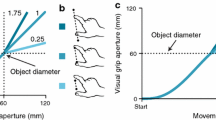Abstract
We examined whether or not conscious knowledge about the availability of visual feedback on an upcoming trial would influence the programming of a precision grip. Twenty healthy volunteers were asked to reach out and grasp objects under two viewing conditions: full visual feedback (closed loop) or no visual feedback (open loop). The two viewing conditions were presented in blocked, randomized, and alternating trial orders. Before each block of trials, participants were explicitly informed of the nature of the upcoming order of viewing conditions. Even though participants continued to scale their grip to the size of the goal objects which varied in size and distance, they opened their hand significantly wider when visual feedback was not available during movement execution. This difference was evident before peak grip aperture was reached, continued into the grip aperture closing phase, and presumably reflects the visuomotor system’s ability to build in a margin of error to compensate for the absence of visual feedback. The difference in grip aperture between closed- and open-loop trials increased as a function of distance, which suggests that the visuomotor system can make use of visual feedback given enough time, even when that feedback is not anticipated. The difference in grip aperture between closed- and open-loop trials was larger when the two visual feedback conditions were blocked than when they were either randomized or alternated. Importantly, performance did not differ between the randomized and the alternating trial blocks. In other words, despite knowledge of the availability of visual feedback on an upcoming trial in the predictable alternating block, participants behaved no differently than they did on randomized trials. Taken together, these results suggest that motor planning tends to optimize performance largely on the basis of what has happened regularly in the past and cannot take full advantage of conscious knowledge of what will happen on a future occasion.



Similar content being viewed by others
References
Bootsma RJ, Marteniuk RG, MacKenzie CL, Zaal FTJM (1994) The speed-accuracy trade-off in manual prehension: effects of movement amplitude, object size and object width on kinematic characteristics. Exp Brain Res 98:535–541
Bruno N, Bernardis P, Gentilucci M (2008) Visually guided pointing, the Müller-Lyer illusion, and the functional interpretation of the dorsal–ventral split: conclusions from 33 independent studies. Neurosci Biobehav Rev 32:423–437
Chang EC, Flanagan JR, Goodale MA (2008) The intermanual transfer of anticipatory force control in precision grip lifting is not influenced by the perception of weight. Exp Brain Res 185:319–329
Elliott D, Allard F (1985) The utilization of visual feedback information during rapid pointing movements. Q J Exp Psychol A 37:407–425
Flanagan JR, Beltzner MA (2000) Independence of perceptual and sensorimotor predictions in the size-weight illusion. Nature Neurosci 3:737–741
Fukui T, Inui T (2006) The effect of viewing the moving limb and target object during the early phase of movement on the online control of grasping. Hum Mov Sci 25:349–371
Grandy MS, Westwood DA (2006) Opposite perceptual and sensorimotor responses to a size-weight illusion. J Neurophysiol 95:3887–3892
Jakobson LS, Goodale MA (1991) Factors affecting higher-order movement planning: a kinematic analysis of human prehension. Exp Brain Res 86:199–208
Jeannerod M (1999) Visuomotor channels: their integration in goal-directed prehension. Hum Mov Sci 18:201–218
Kudoh N, Hattori M, Numata N, Maruyama K (1997) An analysis of spatiotemporal variability during prehension movements: effects of object size and distance. Exp Brain Res 117:457–464
Milner AD, Goodale MA (2006) The visual brain in action, 2nd edn. Oxford University Press, Oxford
Oldfield RC (1971) The assessment and analysis of handedness: the Edinburgh inventory. Neuropsychologia 9:2028–2031
Rand MK, Squire LM, Stelmach GE (2006) Effect of speed manipulation on the control of aperture closure during reach-to-grasp movements. Exp Brain Res 174:74–85
Rand MK, Lemay M, Squire LM, Shimansky YP, Stelmach GE (2007) Role of vision in grip aerture closure during reach-to-grasp movements. Exp Brain Res 181:447–460
Rosenbaum DA, Meulenbroek RJ, Vaughan J, Jansen C (2001) Posture-based motion planning: applications to grasping. Psychol Rev 108:709–734
Schenk T, Mair B, Zihl J (2004) The use of visual feedback and on-line target information in catching and grasping. Exp Brain Res 154:85–96
Schettino LF, Adamovich SV, Poizner H (2003) Effects of object shape and visual feedback on hand configuration during grasping. Exp Brain Res 151:158–166
Smeets JB, Brenner E (1999) A new view on grasping. Motor Control 3:237–271
Smyth MM, Peacock KA, Katamba J (2004) The role of sight of the hand in the development of prehension in childhood. Q J Exp Psychol A 57:269–296
Song JH, Nakayama K (2007) Automatic adjustment of visuomotor readiness. J Vis 20:2–9
Wing AM, Turton A, Fraser C (1986) Grasp size and accuracy of approach in reaching. J Mot Behav 18:245–260
Zelaznik HZ, Hawkins B, Kisselburgh L (1983) Rapid visual feedback processing in single-aiming movements. J Mot Behav 15:217–236
Acknowledgments
This research was supported by a grant from the Natural Sciences and Engineering Research Council of Canada to M.A. Goodale. The authors would like to thank Dr. Haitao Yang for his invaluable assistance in designing the software for this experiment.
Author information
Authors and Affiliations
Corresponding author
Rights and permissions
About this article
Cite this article
Whitwell, R.L., Lambert, L.M. & Goodale, M.A. Grasping future events: explicit knowledge of the availability of visual feedback fails to reliably influence prehension. Exp Brain Res 188, 603–611 (2008). https://doi.org/10.1007/s00221-008-1395-8
Received:
Accepted:
Published:
Issue Date:
DOI: https://doi.org/10.1007/s00221-008-1395-8




